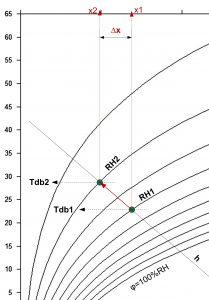When dehumidifying (drying) the air, the absolute water content in the air (absolute humidity) decreases. We achieve this in different ways: in this case by adsorption.
During dehumidification by this method, the air is brought into contact with hygroscopic substances which are able to absorb atmospheric moisture. The most commonly used hygroscopic solid is silica gel (available under the tradename “silica gel“).
Water vapor is absorbed by the relatively large surface of the substance (1 gram of silica gel has a surface of 300 to 500 m2 !!) and condenses. This releases adsorption heat which raises the air temperature, leading to a reduction in both absolute and relative humidity. If silica gel is saturated and efficiency of the process decreases, it can be reactivated by heating to 150 – 200 ° C, eg with hot air.
DehuTech devices are suitable for this kind of dehumidification.
Since air does not transfer or receive heat during this process the enthalpy (h) of the air remains almost constant – sensible temperature rises. In fact, the enthalpy of the proces air-air being dehumidified – actually increases slightly. This is because in many dehumidifiers, a small amount of residual heat from desiccant reactivation vcan be carried into the dry air stream.
The figure shows this state change at the bottom of the h-x diagram.

